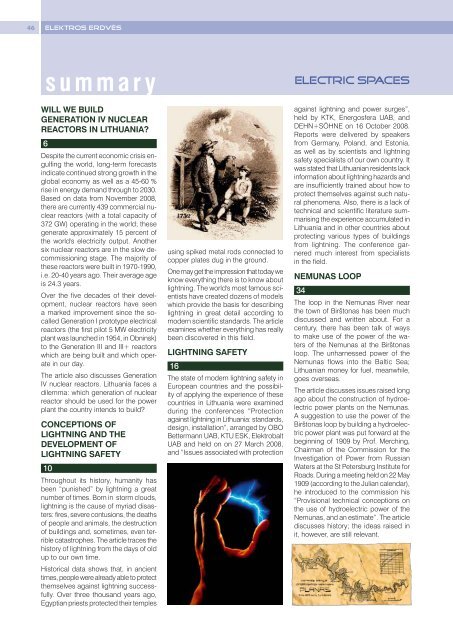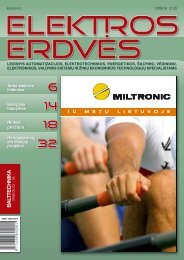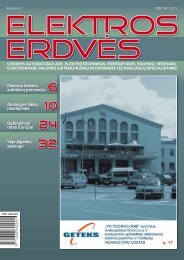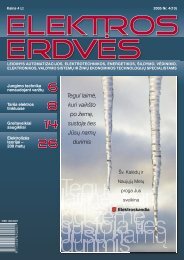Gra ių asmingų uman mų, sti ys štvermės N ujaisiais 2009 ... - NETA
Gra ių asmingų uman mų, sti ys štvermės N ujaisiais 2009 ... - NETA
Gra ių asmingų uman mų, sti ys štvermės N ujaisiais 2009 ... - NETA
You also want an ePaper? Increase the reach of your titles
YUMPU automatically turns print PDFs into web optimized ePapers that Google loves.
46<br />
Elektros Erdvës<br />
summary<br />
WiLL WE BUiLd<br />
GEnERATion iV nUCLEAR<br />
REACToRS in LiTHUAniA?<br />
6<br />
Despite the current economic crisis engulfing<br />
the world, long-term forecasts<br />
indicate continued strong growth in the<br />
global economy as well as a 45-60 %<br />
rise in energy demand through to 2030.<br />
Based on data from November 2008,<br />
there are currently 439 commercial nuclear<br />
reactors (with a total capacity of<br />
372 GW) operating in the world; these<br />
generate approximately 15 percent of<br />
the world's electricity output. Another<br />
six nuclear reactors are in the slow decommissioning<br />
stage. The majority of<br />
these reactors were built in 1970-1990,<br />
i.e. 20-40 years ago. Their average age<br />
is 24.3 years.<br />
Over the five decades of their development,<br />
nuclear reactors have seen<br />
a marked improvement since the socalled<br />
Generation I prototype electrical<br />
reactors (the first pilot 5 MW electricity<br />
plant was launched in 1954, in Obninsk)<br />
to the Generation III and III+ reactors<br />
which are being built and which operate<br />
in our day.<br />
The article also discusses Generation<br />
IV nuclear reactors. Lithuania faces a<br />
dilemma: which generation of nuclear<br />
reactor should be used for the power<br />
plant the country intends to build?<br />
ConCEPTionS oF<br />
LiGHTninG And THE<br />
dEVELoPMEnT oF<br />
LiGHTninG SAFETY<br />
10<br />
Throughout its history, h<strong>uman</strong>ity has<br />
been “punished” by lightning a great<br />
number of times. Born in storm clouds,<br />
lightning is the cause of myriad disasters:<br />
fires, severe contusions, the deaths<br />
of people and animals, the destruction<br />
of buildings and, sometimes, even terrible<br />
catastrophes. The article traces the<br />
history of lightning from the da<strong>ys</strong> of old<br />
up to our own time.<br />
Historical data shows that, in ancient<br />
times, people were already able to protect<br />
themselves against lightning successfully.<br />
Over three thousand years ago,<br />
Egyptian priests protected their temples<br />
using spiked metal rods connected to<br />
copper plates dug in the ground.<br />
One may get the impression that today we<br />
know everything there is to know about<br />
lightning. The world's most famous scientists<br />
have created dozens of models<br />
which provide the basis for describing<br />
lightning in great detail according to<br />
modern scientific standards. The article<br />
examines whether everything has really<br />
been discovered in this field.<br />
LiGHTninG SAFETY<br />
16<br />
The state of modern lightning safety in<br />
European countries and the possibility<br />
of applying the experience of these<br />
countries in Lithuania were examined<br />
during the conferences “Protection<br />
against lightning in Lithuania: standards,<br />
design, installation”, arranged by OBO<br />
Bettermann UAB, KTU ESK, Elektrobalt<br />
UAB and held on on 27 March 2008,<br />
and “Issues associated with protection<br />
electric spaces<br />
against lightning and power surges”,<br />
held by KTK, Energosfera UAB, and<br />
DEHN+SÖHNE on 16 October 2008.<br />
Reports were delivered by speakers<br />
from Germany, Poland, and Estonia,<br />
as well as by scientists and lightning<br />
safety specialists of our own country. It<br />
was stated that Lithuanian residents lack<br />
information about lightning hazards and<br />
are insufficiently trained about how to<br />
protect themselves against such natural<br />
phenomena. Also, there is a lack of<br />
technical and scientific literature summarising<br />
the experience accumulated in<br />
Lithuania and in other countries about<br />
protecting various types of buildings<br />
from lightning. The conference garnered<br />
much interest from specialists<br />
in the field.<br />
nEMUnAS LooP<br />
34<br />
The loop in the Nemunas River near<br />
the town of Birštonas has been much<br />
discussed and written about. For a<br />
century, there has been talk of wa<strong>ys</strong><br />
to make use of the power of the waters<br />
of the Nemunas at the Birštonas<br />
loop. The unharnessed power of the<br />
Nemunas flows into the Baltic Sea;<br />
Lithuanian money for fuel, meanwhile,<br />
goes overseas.<br />
The article discusses issues raised long<br />
ago about the construction of hydroelectric<br />
power plants on the Nemunas.<br />
A sugge<strong>sti</strong>on to use the power of the<br />
Birštonas loop by building a hydroelectric<br />
power plant was put forward at the<br />
beginning of 1909 by Prof. Merching,<br />
Chairman of the Commission for the<br />
Inve<strong>sti</strong>gation of Power from Russian<br />
Waters at the St Petersburg In<strong>sti</strong>tute for<br />
Roads. During a meeting held on 22 May<br />
1909 (according to the Julian calendar),<br />
he introduced to the commission his<br />
“Provisional technical conceptions on<br />
the use of hydroelectric power of the<br />
Nemunas, and an e<strong>sti</strong>mate”. The article<br />
discusses history; the ideas raised in<br />
it, however, are <strong>sti</strong>ll relevant.






